This article was co-authored by David Engel. David Engel is a Muay Thai Instructor and Self Defense Trainer based in the San Francisco Bay Area. With over 15 years of martial arts instruction and training experience, David runs California Martial Athletics with co-owner Joe Chernay. He has created and maintained martial arts programs at Rise Combat Sports in San Francisco and Round 5 Martial Arts Academy in San Leandro, with a mission to provide students with a level of comfort and competency that manifests both within and outside the martial arts context. He is also a registered cornerman for amateur and pro competitors under the IKF (International Kickboxing Federation). David was the youngest apprentice instructor of the Thai Boxing Association of America under Ajarn Chai Sirisute (2009), and was a top-ranked amateur competitor in his weight class (127-130 lb) in California between 2013 and 2015.
wikiHow marks an article as reader-approved once it receives enough positive feedback. In this case, 95% of readers who voted found the article helpful, earning it our reader-approved status.
This article has been viewed 119,177 times.
While there are many types of kicks in Taekwondo, the front kick is the first one you’ll learn during your training. Called Ap Chagi in Korean, this kick will form the foundation for more difficult kicks that you’ll learn in the future.
Steps
Assuming Your Fighting Stance
-
1Stand with one foot facing forward. In Taekwondo, kicks are launched from the standard L-stance, where one foot will be placed in front of the other. It’s up to you which foot is in front, depending on whether the left or right side of your body is dominant.
- Your back leg will be your kicking leg, as it's going to snap out and perform the strike. Your front leg is your supporting leg, as it's going to be holding all of your body's weight as you pick your kicking leg off the ground and kick.
- If you favor your right hand, your right leg will most likely be your dominant leg. You'll want it to be your back leg, or kicking leg. If you favor your left hand, make your left leg your back leg, or supporting leg.
- Your front and back leg should be about one and half shoulder-widths apart. To reach this measurement, take your stance with your feet directly under your shoulders, then move your supporting leg front one step and your kicking leg back one step.[1]
-
2Line up your back foot. The name “L-Stance” comes from the L shape that you’ll make with your feet in this stance. Your front foot should face forward, and your back foot and leg should be turned out 90 degrees, placed about one foot behind the front foot. Your forward-facing supporting foot should be facing towards your target, getting ready to guide your kick in the right direction.Advertisement
-
3Position your trunk and head. With your feet in proper L stance, your body won’t be facing forward: it will be facing slightly outward in the direction that your back foot is pointed. You’ll want to be looking ahead, however, so point your head towards your opponent or target and focus on its direction.
- Face your trunk outward. Since your kicking foot is pointed about 90 degrees away from your body and your supporting foot is facing forward, this will leave your body pointing about 45 degrees diagonal towards your target. Try to keep an even smaller profile by rotating your trunk towards your back foot. The less your opponent can see of your body, the less they can hit.
- Face your head forward. While your torso is rotated at a 45 degree angle, you still need to be able to see! Face your head forward and keep your eye fixed on your target. This will help guide your kick.
-
4Position your arms. In most Taekwondo ready stances, you’ll want your arms out in front of you in a blocking position. Even though you won’t be punching, hold your hands in fists facing each other about a foot in front of your chest, with your elbows bent at 90 degree angles. Your arms will help you balance as you kick.[2]
-
5Shift your weight. Make sure about 75 percent of your weight is resting on your front foot. This will be important when you kick: you want as much weight off of your back foot as possible so that you can snap it upward quickly.
Lifting Your Front Leg
-
1Lift your back knee. Lift it high enough so that the instep of your back foot is about level with your front knee. Hold this stance and get comfortable with your balance. You don’t want to fall over!
-
2Point your knee towards your target. Your knee should be slightly above the exact point that you are aiming for, with your kicking foot stretched to become parallel to the ground. You may need to pull your arms closer to your body as you lift higher to maintain your balance.
-
3Pay attention to your kicking foot. Your back foot is the foot that you’ll be using to strike the target, so you’ll want to make sure that it’s in the right position. As you point your knee towards the target, pull your toes upward so that your foot is parallel to the ground, ready to deal the blow.
Executing the Front Kick
-
1Snap your leg up. Snap your leg up at the knee with your toes pointed up. You want to get a lot of momentum going here: the more force and speed you put into the snap, the more force you’ll hit your target with. [3]
-
2Strike the target! You want to hit the target with either the ball of your foot or your instep. Both are acceptable, and up to you or your instructor’s preference. The point of the kick is to cover as much area as possible to make as large an impact as you can. Just make sure that you’re not striking with your toes only! You could break or sprain them.
-
3Pull your foot back. Return your foot back to the starting position, with your kicking foot and supporting foot in the “L-Stance”. Regain your balance and make sure that your arms are back down to their original position as well.
-
4Practice! Make sure to repeat the steps in solo practice and in formal sparring matches. Work on your balance, your form, and the speed with which you snap your kick.
Expert Q&A
-
QuestionHow can improve my footwork for Taekwondo?
 David EngelDavid Engel is a Muay Thai Instructor and Self Defense Trainer based in the San Francisco Bay Area. With over 15 years of martial arts instruction and training experience, David runs California Martial Athletics with co-owner Joe Chernay. He has created and maintained martial arts programs at Rise Combat Sports in San Francisco and Round 5 Martial Arts Academy in San Leandro, with a mission to provide students with a level of comfort and competency that manifests both within and outside the martial arts context. He is also a registered cornerman for amateur and pro competitors under the IKF (International Kickboxing Federation). David was the youngest apprentice instructor of the Thai Boxing Association of America under Ajarn Chai Sirisute (2009), and was a top-ranked amateur competitor in his weight class (127-130 lb) in California between 2013 and 2015.
David EngelDavid Engel is a Muay Thai Instructor and Self Defense Trainer based in the San Francisco Bay Area. With over 15 years of martial arts instruction and training experience, David runs California Martial Athletics with co-owner Joe Chernay. He has created and maintained martial arts programs at Rise Combat Sports in San Francisco and Round 5 Martial Arts Academy in San Leandro, with a mission to provide students with a level of comfort and competency that manifests both within and outside the martial arts context. He is also a registered cornerman for amateur and pro competitors under the IKF (International Kickboxing Federation). David was the youngest apprentice instructor of the Thai Boxing Association of America under Ajarn Chai Sirisute (2009), and was a top-ranked amateur competitor in his weight class (127-130 lb) in California between 2013 and 2015.
Muay Thai Instructor & Self Defense Trainer Running is always going to be your number one priority if you're trying to improve your footwork. Running more than 5 miles regularly will help with recovery in between rounds. Sprinting uphill a few days every week is great as well, since this can kind of simulate the chaos of a fight.
Running is always going to be your number one priority if you're trying to improve your footwork. Running more than 5 miles regularly will help with recovery in between rounds. Sprinting uphill a few days every week is great as well, since this can kind of simulate the chaos of a fight. -
QuestionWhat is the color of the beginner belt in taekwondo?
 Community AnswerWhen you begin taekwondo, you will get a white belt and move up from there. You then get a yellow belt, orange belt, then green belt. Higher rank belt colors vary depending on what taekwondo group you are in.
Community AnswerWhen you begin taekwondo, you will get a white belt and move up from there. You then get a yellow belt, orange belt, then green belt. Higher rank belt colors vary depending on what taekwondo group you are in. -
QuestionCan I learn taekwondo even if I'm slightly fat? My friend told me that I wouldn't be able to.
 Community AnswerNo, being fat does not matter. Taekwondo will help you to become more fit. Do not believe what your friend told you, if you want to try taekwondo, you should do it.
Community AnswerNo, being fat does not matter. Taekwondo will help you to become more fit. Do not believe what your friend told you, if you want to try taekwondo, you should do it.
Warnings
- Always warm up and stretch before performing kicks. You may strain or tear muscles by kicking when you’re not properly warmed up.⧼thumbs_response⧽
- Be careful striking with your heel! Shock from striking with your heel can travel up the rest of your shin, creating a stress fracture if you kick very hard.⧼thumbs_response⧽
- If you injure yourself practicing this or other kicks, see a doctor immediately.⧼thumbs_response⧽
- Don’t use this move for self-defense unless you have been properly trained! Taekwondo classes and sparring matches are safe places to practice these moves, but you can easily injure yourself by using this kick for street fights or common self-defense.⧼thumbs_response⧽
- Consult your Doctor before beginning any new exercise regimen.⧼thumbs_response⧽


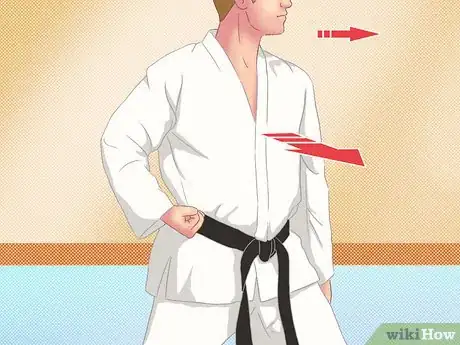

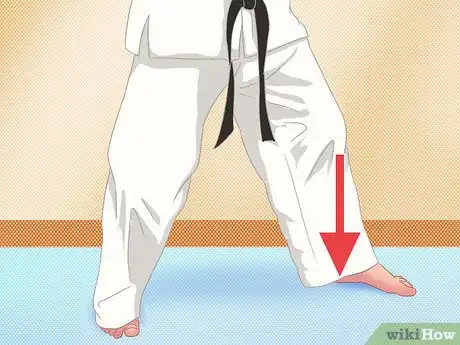

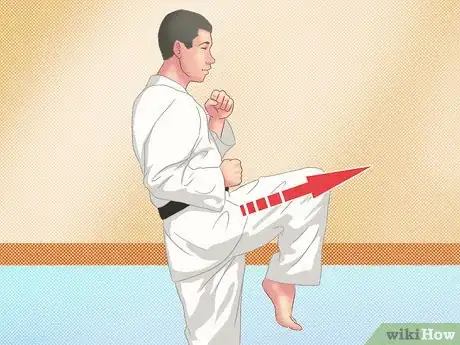
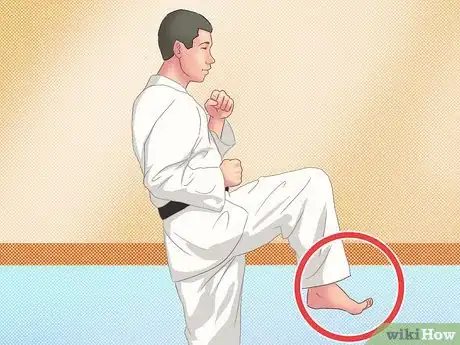
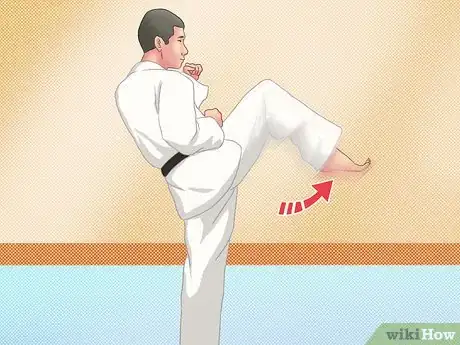
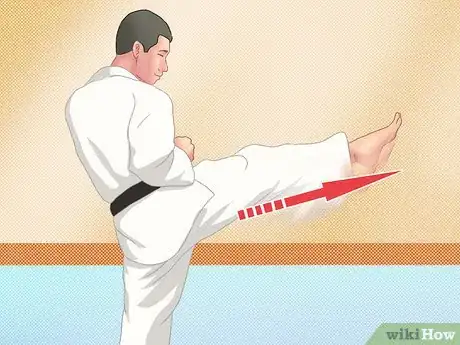
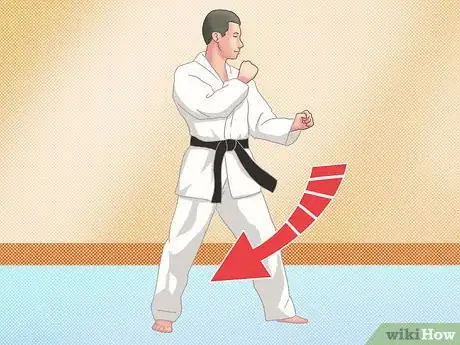
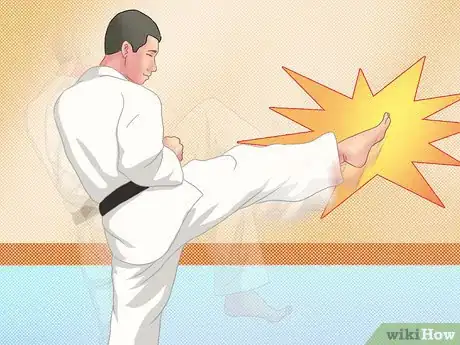

-Step-15-Version-2.webp)



















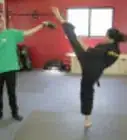

-Step-15-Version-2.webp)


































